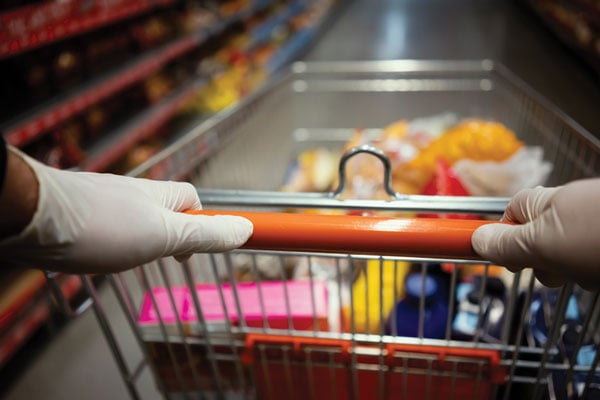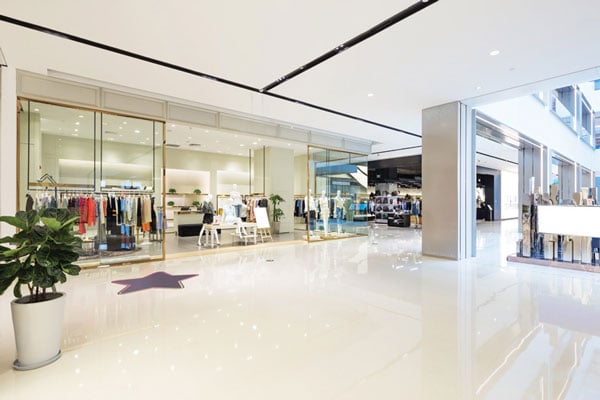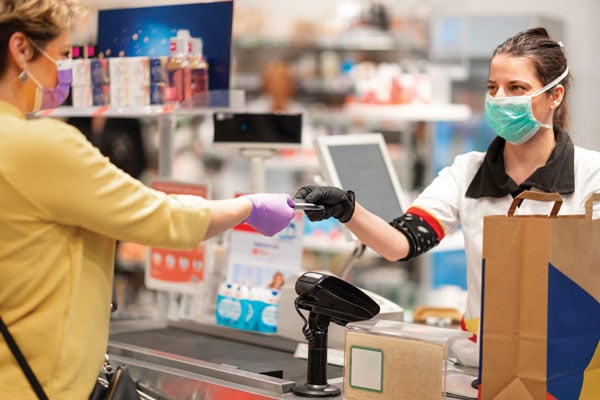Pain Spreads Wide in Retail and Hospitality

The effects of the coronavirus hit these sectors earlier, faster and more deeply than other areas of commercial real estate.
Fears of contracting the coronavirus, government bans on public gatherings, mandatory closures of nonessential businesses and social distancing measures pose ongoing challenges to the retail and hospitality sectors. Many stores have been forced to temporarily close their doors in response to government mandates or in reaction to sharp declines in foot traffic.
The coronavirus crisis could also hasten the failure of retailers that are heavily indebted or have poor cash flow. The Wall Street Journal noted in March that junk-bond-rated retailers that are particularly reliant on Chinese imports are most vulnerable to the effects of the virus. Healthier retailers may eventually recoup some of their losses after the outbreak when consumers return to stores to satisfy pent-up demand for goods and services.
Retail ‘Is Really Going to Struggle’
Since the pandemic hit, the retail sector has struggled mightily, particularly small businesses. In mid-May, the Commerce Department reported that retail sales fell 16.4% in April, the largest decline ever recorded. Coresight Research recently reported that foot traffic at U.S. retail outlets fell 60% in March, with much of that decline coming at the end of the month as social-distancing measures were put in place across the country.

Because they were declared an essential service, grocery stores have endured during the coronavirus pandemic. Getty Images
And an April survey from the Harvard Business School found that an extended lockdown could force 65% of small businesses to close by the end of the year.
“There’s going to be a lot of empty storefronts,” said Anirban Basu, CEO of Baltimore-based economic consultants the Sage Policy Group, during a webinar for NAIOP D.C.-Maryland. “And we already had so many retailers on the verge.”
2019 was already a record year for store closings, Basu said. According to an analysis by Business Insider, more than 9,300 stores closed their doors permanently last year.
“That happened during a time when the economy was strong and consumers were spending aggressively,” Basu said. “Now imagine what happens. The retail part of commercial real estate is really going to struggle.”
Malls, especially those anchored by large department stores, are among the worst-hit properties. In January, real estate research firm Green Street Advisors noted that department store chains represent roughly 30% of all mall square footage in the U.S., according to an April report in the New York Times.
“The department stores, which have been failing slowly for a very long time, really don’t get over this,” Mark A. Cohen, the director of retail studies at Columbia University’s Business School, told the newspaper.
In May, longstanding department store brands J.C. Penney and Neiman Marcus declared bankruptcy. Clothing retailer J. Crew did as well. And Pier 1 announced that it would close all its retail locations.
Many restaurants are also in jeopardy. The National Restaurant Association reports that U.S. eateries lost $25 billion during a three-week period in March, and around three million workers were laid off. About 44% of restaurants suspended operations during that time.
In May, Moody’s Analytics predicted that effective rents for retail properties would fall 11% in 2020, nearly double the decline seen during the financial crisis from 2008 to 2011.Also in May, S&P Global Ratings reported that about 30% of the 125 retail and restaurant companies it tracks could be close to bankruptcy or liquidation.
E-Commerce’s Moment?
While multi-trillion-dollar government stimulus packages could help restaurants survive the pandemic, e-commerce might be a deciding factor for many of them. Delivery and pickup accelerated after millions were forced to stay home and restaurants were ordered to halt sit-down service.
Between March 1-25, marketing firm NetElixir reported that online food sales surged 183% compared with the same period last year.

Shopping malls that depend on department stores as anchors could face challenges in the post-pandemic retail landscape. Getty Images
“I think the long-term impact is that the people who have been shopping online will continue to shop online,” said Elie Finegold, a veteran entrepreneur and global property executive, during a webinar with real estate experts in Europe and North America. “But there’s a whole class of people who have not been shopping online, at least for groceries and other basics. I think there’s going to be a big uptick in online shopping, because there’s a whole class of people who have been forced to shop online and they’re going to stay with it.”
Along those lines, Hessam Nadji, CEO of Marcus & Millichap, said the coronavirus pandemic is hastening trends that were already occurring across all of retail.
“As you know, e-commerce has profoundly changed brick-and-mortar retailing, and a lot of obsolete, older shopping centers, especially those that rely on department stores, have been hurt badly by what was already happening,” he said in an interview with Bloomberg. “This is just speeding that up. But I think there’s going to be more short-term pain because of it. There is no way around that.”
Al Pontius, national director of office and industrial with Marcus & Millichap, thinks that the pandemic will diminish some retail concepts, or at least the number of units. But he also sees opportunities.
“There will be growth sectors or opportunities emerging that we’re not contemplating right now,” he said during a recent NAIOP webinar. “Retail has been a rapidly morphing area for years. It’s certainly logical to assume that what we’re learning and acclimating to in the online world is going to push change going forward.”
Pontius said that many retailers have already determined that having physical locations in concert with online presence has been the best formula to drive activity. He expects that trend will continue, though he thinks it’s too early to say if it will be any more significant than what was happening before the pandemic.
Antony Slumbers, a U.K.-based software development and technology strategist in commercial real estate, thinks that the pandemic could force technological advances into the retail market very quickly.
“Retail should consolidate its systems,” he said during a webinar with real estate experts in Europe and North America. ”You’ve got this omnichannel idea, but you end up with retailers who have one system to run their stores and another to run their online sales. These things need to come together.”
Slumbers thinks that the pandemic will highlight the differences between retailers who have synchronized their online and offline systems and think as a one-system retailer and those who have an online option but don’t really pay a lot of attention to it.
“We will still want retail stores, but we’re going to want a really good human experience,” he said. “Otherwise, why bother? I also think you’re going to see a bifurcation of the really good digital stuff and the really good human-centric stuff. We need both.”
Dror Poleg, a former real estate and technology executive, thinks that the big winners in e-commerce will be giants who are already hugely successful in that space.
He observed that major e-commerce players such as Walmart and Amazon began a hiring frenzy at a time when more than 30 million were out of work in the U.S.
“They’re really taking advantage of their ability to be fully integrated, to make sure their supplies come in, to tie in their online and of online sales, and to automate some of the store experience to prevent their employees from being exposed to the virus,” he said during a webinar with real estate experts in Europe and North America.
Bright Spots Beyond E-Commerce
Spencer Levy, Americas head of research and senior economic advisor with CBRE, said grocery- or pharmaceutical-anchored centers are pulling in record sales.

Safety will be a major concern in the retail sector following the COVID-19 pandemic. Stores will have to ensure a sanitary experience for both customers and employees. Getty Images
In March, as the pandemic started to grip the U.S., year-over-year traffic c rose by 36% at Kroger stores and by 40% at Albertsons outlets, according to Placer.ai, a company that measures retail activity. Major pharmacies such as CVS and Rite Aid also saw spikes in traffic that approached 30%.
“Grocery chain H-E-B in Texas takes in about $1 million a week at a typical store,” Levy said during a recent webinar for NAIOP Maryland. “In March, they were taking in about $1 million a day. That’s a pretty good example of how strong the grocery space has been during this period.”
Online grocery retailers saw a whopping 210% increase in sales from March 12 to 15 compared with the same period in 2019, according to Rakuten Intelligence.
Additionally, Nadji notes that fastfood restaurants and single-tenant retail where there is one store on a long-term lease are also surviving — and in some cases thriving. (These are often big-box stores such as Home Depot, many of which were deemed essential by state and local governments and allowed to stay open.)
Hotels Struggle
At the same time, prohibitions on public meetings have drastically affected businesses that serve conventions.
A report from Bloomberg shows that up to 80% of the 2,500 business trade shows and events originally scheduled for March to mid-May have been cancelled or postponed, resulting in losses of $22 billion to conference organizers, hotels, restaurants and other related firms. Bloomberg predicts that hotels will likely experience the effects of cancelled or postponed business meetings, conferences and personal trips through the first half of 2020.
“Over 50% of hotels have gone to almost total shutdown today,” Levy said. “I am directly aware of lenders who have reached out specifically to hotel borrowers that have personal guarantees and told them that they would forbear on their loans for three months unsolicited. So people are going out of their way, certainly in the bank space, to help people in the hotel space.”
Across-the-board declines in room reservations are leading many hoteliers to furlough or lay off most of their staff. Major hotel operators like Marriott, Hilton and Hyatt have cut thousands of staff, while smaller hotel chains have laid off 90%-95% of their workforce, according to the Wall Street Journal.
Looking Ahead
Federal stimulus is providing loan guarantees for hotels and retailers, including restaurants. However, some businesses in these sectors may no longer be viable, and it is unclear whether those that receive government support will employ as many workers as they did prior to the outbreak.
Despite that, many analysts think that the human desire for connection will help retail rebound.
“The day this is all over, you’re going to see restaurants packed with people,” Levy said.
Julia Cambage, chief executive of the Australian Institute of Architects, told Australia’s Commercial Real Estate website that people will rediscover the importance of community after the pandemic, and bricks-and-mortar retail will return.
“My own personal view is that high street shopping precincts will become more relevant,” she said. “I think people will want their community closer to them.”
Despite that, health concerns will become a much more important consideration for customers.
“Until now, people just wanted a seat at that neighborhood restaurant and it didn’t matter what was around them,” Carl Bialik, data science editor at online review site Yelp, told Axios. “Now there will be a spotlight on how establishments are adhering to health standards. That’s going to be more relevant than ever before.”
Along those lines, look for more “touchless” payment options such as Apple Pay and Google Wallet to reduce the use of pens or screens, which can be vectors for disease transmission. Stores and restaurants might also reduce occupancy levels so they can space out tables to meet “social distancing” guidelines, either voluntarily or because of government mandates. Other measures could include oneway foot-traffic patterns in grocery stores, plexiglass screens to protect workers, automated doors for touchfree entrance and exit, and moving more restaurant seating outside when the weather permits.
Regardless of what happens after the pandemic subsides, it seems certain that retail will adapt. With consumer spending representing about 70% of economic activity in the U.S., it might be an imperative.
“People talk a lot about the death of retail, but I also want to point out the rebirth of retail,” Nadji said. “We have so many examples of renovation, repositioning and retenanting of retail that have been wildly successful.”
Timothy H. Savage, a clinical assistant professor at New York University’s Schack Institute of Real Estate, said retail has been evolving for more than 100 years.
“Arguably, Amazon is just a digital version of the Sears & Roebuck catalog,” he said during a recent NAIOP webinar. “What we purchase isn’t changing very much, but the mechanism by which it’s distributed is changing a lot.”
Shawn Moura, Ph.D., is research director at NAIOP. Trey Barrineau is managing editor, publications, for NAIOP.
Many Retailers See a Long RecoveryIn April, McKinsey & Company researchers surveyed 98 U.S.-based executives in apparel, department stores, off-price stores, beauty, and big-box and small-box specialty retail about what they expect in a post-pandemic world. Some of the results:
|
Small-Business Pessimism About COVID-19 ImpactsA survey of 5,800 small businesses that was published in April by the National Bureau of Economic Research asked respondents this question: “Suppose that most COVID-19 disruptions continue for six months. What is the likelihood of your business remaining operational?” The responses, by percentages: 33%: All retail (except grocers) 27%: Hotels 22%: Personal services 15%: Restaurants and bars |




